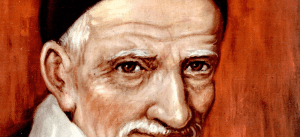I am not an optometrist so I certainly cannot speak about our physical sight. Obviously, I am speaking about spiritual sight and insight.
I think particularly of Vincent. It took him until midlife to begin to see clearly. And he spent the rest of his life learning to see more clearly. At the end of his life, he saw very clearly
Seeing Christ

Two things triggered my preoccupation with this theme of sharper sight in later years.
First, I had just read a thought-provoking article entitled “If You Can’t See These People, You Can’t See Christ”
The Scriptures are clear that Jesus was born into poverty as an oppressed minority. The only begotten Son of God, who was in the beginning as God and with God, speaking creation into existence (John 1), came to Earth as a Jewish, multiethnic, poor and marginalized human being.
This ought to challenge, inform and guide how the Christian lives in society today.
How we see the poor, the oppressed, the marginalized, the immigrant, and the incarcerated is directly connected to how we see Christ. If we see these people falsely, then we see Christ falsely. How we treat the poor, the oppressed, the marginalized, the immigrant and the incarcerated is directly related to our intimacy with God, or lack thereof. This truth is shown to us in Matthew 25.
The second thought that kept feeding this reflection came from being the principal celebrant at our community Mass on the feast of St. John Chrysostum. In preparing thoughts to share I came across a quote attributed to him “If you cannot find Christ in the beggar at the Church door, you will not find him in the Chalice.”
I was haunted by that phrase for the next few days. I began to think not of all the beggars I meet but of all the people I meet in the course of a day. It raised the question whether for me is this just pious poetry or something I really see… as I think Vincent did as he advanced in age.
 Vincent’s strengthening sight
Vincent’s strengthening sight
The more Vincent grew in wisdom, age and grace the more clearly he saw.
In his later years, Vincent reflected:
“I shouldn’t judge poor peasants, men or women, by their surface appearance, nor by their apparent mental capacities. And this is hard to do, since very frequently they scarcely seem to have the semblance or the intelligence of reasonable beings, so gross and so offensive are they. But, turn the coin, and you will see by the light of faith that the Son of God, Whose will it was to be poor, is represented to us by just these people. (XI Conference #19, p.32)
Most of the visitors to this site know this story very well. But for me today “turning the coin” applies most directly to each and every person I meet during the course of my day. For me, the acid test is not with the beggars at the church door (I can prep myself for these encounters) but in my ordinary encounters with each and every person.
Reflections questions
- Is it easier for me to see Christ in the beggar than in the ordinary people I encounter each day?
- How can I learn to see what Vincent saw more clearly in his later years?








0 Comments